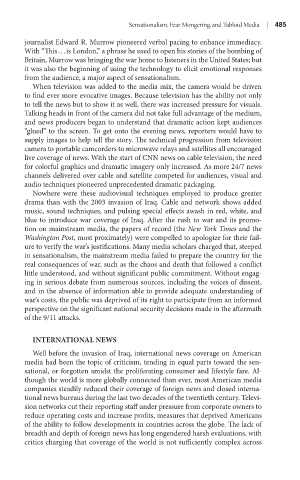Page 506 - Battleground The Media Volume 1 and 2
P. 506
Sensat onal sm, Fear Monger ng, and Tablo d Med a |
journalist Edward R. Murrow pioneered verbal pacing to enhance immediacy.
With “This . . . is London,” a phrase he used to open his stories of the bombing of
Britain, Murrow was bringing the war home to listeners in the United States; but
it was also the beginning of using the technology to elicit emotional responses
from the audience, a major aspect of sensationalism.
When television was added to the media mix, the camera would be driven
to find ever more evocative images. Because television has the ability not only
to tell the news but to show it as well, there was increased pressure for visuals.
Talking heads in front of the camera did not take full advantage of the medium,
and news producers began to understand that dramatic action kept audiences
“glued” to the screen. To get onto the evening news, reporters would have to
supply images to help tell the story. The technical progression from television
camera to portable camcorders to microwave relays and satellites all encouraged
live coverage of news. With the start of CNN news on cable television, the need
for colorful graphics and dramatic imagery only increased. As more 24/7 news
channels delivered over cable and satellite competed for audiences, visual and
audio techniques pioneered unprecedented dramatic packaging.
Nowhere were these audiovisual techniques employed to produce greater
drama than with the 2003 invasion of Iraq. Cable and network shows added
music, sound techniques, and pulsing special effects awash in red, white, and
blue to introduce war coverage of Iraq. After the rush to war and its promo-
tion on mainstream media, the papers of record (the New York Times and the
Washington Post, most proximately) were compelled to apologize for their fail-
ure to verify the war’s justifications. Many media scholars charged that, steeped
in sensationalism, the mainstream media failed to prepare the country for the
real consequences of war, such as the chaos and death that followed a conflict
little understood, and without significant public commitment. Without engag-
ing in serious debate from numerous sources, including the voices of dissent,
and in the absence of information able to provide adequate understanding of
war’s costs, the public was deprived of its right to participate from an informed
perspective on the significant national security decisions made in the aftermath
of the 9/11 attacks.
inTErnaTionaL nEws
Well before the invasion of Iraq, international news coverage on American
media had been the topic of criticism, tending in equal parts toward the sen-
sational, or forgotten amidst the proliferating consumer and lifestyle fare. Al-
though the world is more globally connected than ever, most American media
companies steadily reduced their coverage of foreign news and closed interna-
tional news bureaus during the last two decades of the twentieth century. Televi-
sion networks cut their reporting staff under pressure from corporate owners to
reduce operating costs and increase profits, measures that deprived Americans
of the ability to follow developments in countries across the globe. The lack of
breadth and depth of foreign news has long engendered harsh evaluations, with
critics charging that coverage of the world is not sufficiently complex across

